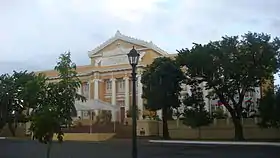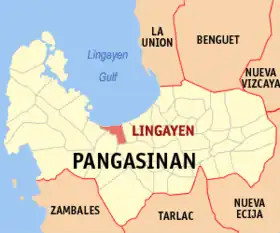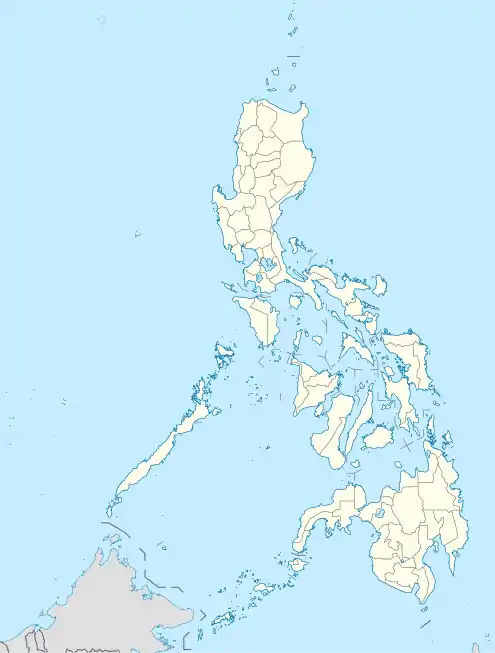Lingayen
Lingayen est une ville de 1re classe, capitale de la province de Pangasinan aux Philippines. Selon le recensement de 2010 elle est peuplée de 98 704 habitants.
| Lingayen (tl) Baley ng Lingayen (ilo) Baley na Lingayen (fil) Ili ti Lingayen | ||
 Le Capitole de Lingayen | ||
| Administration | ||
|---|---|---|
| Pays | ||
| Région | Ilocos | |
| Province | Pangasinan | |
| Barangays | 32 | |
| Maire | Ernesto C. Castañeda, Jr. | |
| Code postal | 2401 | |
| Démographie | ||
| Gentilé | Lingayenses | |
| Population | 98 704 hab. (2010) | |
| Densité | 1 573 hab./km2 | |
| Géographie | ||
| Coordonnées | 16° 01′ 12″ nord, 120° 13′ 51″ est | |
| Superficie | 6 276 ha = 62,76 km2 | |
| Localisation | ||

| ||
| Géolocalisation sur la carte : Philippines
| ||
| Liens | ||
| Site web | http://www.lingayen.gov.ph/ | |
Lingayen a été un des points stratégiques de la Seconde Guerre mondiale. C'est aussi la ville de naissance du président Fidel Ramos. Lingayen est considérée comme « l'endroit le plus romantique aux Philippines ».
Barangays
Lingayen est divisée en 32 barangays.
- Aliwekwek
- Baay
- Balangobong
- Bantayan
- Basing
- Capandanan
- Domalandan central
- Domalandan occidental
- Domalandan oriental
- Dorongan
- Dulag
- Estanza
- Lasip
- Libsong oriental
- Libsong occidental
- Malawa
- Malimpuec
- Maniboc
- Matalava
- Naguelguel
- Namolan
- Pangapisan du Nord
- Pangapisan du Sud
- Poblacion
- Quibaol
- Rosario
- Sabangan
- Talogtog
- Tonton
- Tumbar
- Wawa
Démographie
| Année | Habitants | Évolution |
|---|---|---|
| 1995 | 80 758 | - |
| 2000 | 88 891 | 10,07 % |
| 2007 | 95 773 | 7,74 % |
| 2010 | 98 704 | 3,06 % |
- Portail des Philippines
Cet article est issu de Wikipedia. Le texte est sous licence Creative Commons – Attribution – Partage à l’identique. Des conditions supplémentaires peuvent s’appliquer aux fichiers multimédias.
